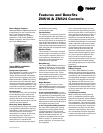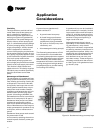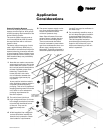
22 WSHP-PRC001-EN
Flexibility
The high efficiency vertical and hori-
zontal water-source heat pump sys-
tem is versatile for installation in
boiler/cooling tower applications, as
well as ground-source (geothermal)
applications. The system design may
employ either a central pumping de-
sign, or a distributed pumping design.
A central pumping design involves a
single pump design, usually located
within a basement or mechanical
room to fulfill pumping requirements
for the entire building system. An aux-
iliary pump is typically applied to less-
en the likelihood of system downtime
if the main pump malfunctions.
A distributed pumping system con-
tains a single pump module connected
directly to the units supply and return.
This module is field installed and
piped to the unit. This design requires
individual pump modules specifically
sized for each water-source heat
pump.
Advantages of Geothermal
The advantages of a geothermal heat
pump system could literally cut a busi-
ness’ heating and cooling costs by 30
to 40-percent. The units are durable,
and typically last longer than conven-
tional systems because they are pro-
tected from harsh outdoor weather
conditions, and because the unit is in-
stalled indoors and the loop under-
ground. (According to ASHRAE, the
estimated service life for a commercial
water-to-air heat pump is 19-years.)
Geothermal heat pumps have fewer
mechanical components, making
them more reliable and less prone to
failure. Manufacturers of the loop ma-
terials guarantee their products for up
to 25-years, with no maintenance re-
quired.
Geothermal heat pumps work toward
the preservation of the
environment by reducing the environ-
mental impacts of electric power gen-
eration.
A ground source (geothermal)
system consist of a:
• A ground water heat pump
• A closed loop ground heat ex-
changer made of high density
polyethylene pipe (guaranteed
25- years or more by many man-
ufacturers); and
• A low wattage circulating pump(s)
The fluctuating temperatures of fluid
from the earth are more stable than
air, allowing the equipment to operate
at a lower discharge pressure and use
fewer kilowatts. The constant earth
temperature will heat or cool the fluid
running through buried high density
polyethylene pipe to provide heating
and cooling to a building.
A geothermal loop can be installed ei-
ther horizontally or vertically. Vertical
loops require less overall land area to
reject (i.e., sink) the excess heat from
the building. Horizontal loops require
trenches in the ground spanning a
larger overall land area.
Although external piping is the re-
sponsibility of the installer and/or pip-
ing manufacturer, many electric
utilities and rural electric cooperatives
are offering monetary incentives to in-
stall geothermal systems. Utility com-
panies offer the incentives because of
reduced peak loads that flatten out
their demand curve over time, and
save them money. These savings are
ultimately transferred to the consum-
er. See Figure 31 for geothermal ener-
gy recovery loop.
Application
Considerations
Figure 31: Geothermal energy recovery loop


















